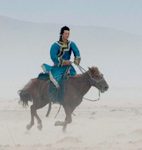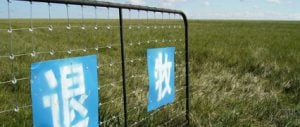On November 12, two herders from Khaskatun in Inner Mongolia wrote to the local authority petitioning it to protect the Mongolian Baicha horse (or “Iron Hoof”) and the culture that comes with it. They believe that, unchecked, a new local-government policy will soon drive this rare breed to extinction.
In March, the Khaskatun government banned herders from putting horses and goats out to pasture all year round in order to “protect the grasslands”. Village and town authorities followed this up by setting actual time limits for grazing and telling herders to provide fodder for their horses in order to protect grassland vegetation.
When they heard about the policy, two horse herders called Baoyin Dalai and Alateng rushed out to borrow money and buy up Baicha horses. As far as they are concerned, these animals are not to blame for the deteriorating state of the grasslands. Moreover, they are the key emblem of the Khaskatun grasslands’ culture and history – and, as such, indispensable.
In August, I visited the two herdsmen and the horses they are protecting. Below Baiyin Aobao Mountain, thickets of trees cast patterns of light and shade over yellowing grass. A small herd of horses, kicking up clouds of dust, weaved around a corral with Baoyin Dalai riding at their rear, looking magnificent with lasso in hand. Yan Jun, a neighbouring villager who had dropped by, told me herds of horses like this used to be a common sight – but now even small groups of 10 or so are rare.
Baoyin Dalai and Alateng have put everything into this group of a dozen or so horses, seven of which were frantically bought from Baichagou, where the horses originate, before the new policy came into effect, using a high-interest loan of 60,000 yuan (US$9,000).
Khaskatun grassland lies north-west of Inner Mongolia’s Chifeng city and borders Xilin Gol prefecture. It boasts ample rainfall and varied landscapes, is close to both Beijing and Shangdu – or Xanadu as it is widely known in the west – and has a rich history and culture. The Baicha horse is one embodiment of that. Historical documents and stories say these were war horses left behind by the Mongol army as it fled China at the end of the Yuan dynasty. Baicha horses, just one of several famous Mongolian breeds, are small but tough, and take their Mongolian name – literally “iron hoof” – from their ability to walk on stony ground. They originate in the rugged area of Baicha, hence their other name. Baicha is now a Chinese farming area, but the breed of horses is still relatively pure.
Professor Manglai, secretary-general of the China Horse Industry Association and deputy dean of Inner Mongolia Agricultural University, told chinadialogue that the genuine Mongolian horse comprises just four breeds – the Wuzhumuqin white horse, the Wushen, the Abaga black horse and the Baicha. In 1975, there were well over 2 million horses in Inner Mongolia. Now, just half a million remain and the population is shrinking by 5% to 6% each year. And, of the survivors, only 100,000 are genuine Mongolian horses. “The Baicha is the rarest of the four types, with only several dozen left,” says Manglai. “If we don’t protect them they’ll be extinct in no time.”
Manglai, now 50, was born into a grassland herding family. As a child, he rode horses and took them out to pasture – and so he well understands what the plummeting horse population means. He says that increased mechanisation and better transport have lessened people’s need for the animals. Economic reforms in the 1980s also led villages to parcel out livestock: “Our village had over 2,000 horses then, so say everyone got three or four, a family of three would get nine horses. But raising horses on the grasslands needs to be done in large herds and managing those herds is a really specialised job. Not everyone could look after the horses, so they sold them and numbers fell.”
At the same time, land was allocated to households and fenced off. Mongolian horses are semi-wild and need huge areas of land to graze on freely. Many families didn’t have enough land and, again, had to sell off the animals.
Hai Shan, a professor at Inner Mongolia Normal University’s School of Geography, says that the five types of livestock on the Mongolian grasslands – the Mongolian horse, camels, cows, goats and sheep – have existed here for a million years and are closely bound up with the grassland system as a whole.
Of these five animals, the horse is the spirit of the local ecology. In nomadic times, it was the horse that drove the way of life: in the search for freshwater and the newest grass, horses would never stay in one place for long, and so the herders and other livestock also moved on regularly, allowing the grasslands to recover. The damage to the grasslands seen today is not caused by livestock eating the grass, but by fenced-in animals repeatedly walking over the same areas. As the old herders say, you can’t eat the grass up, but you can trample it to death. The Mongolian grasslands are an extremely vulnerable ecosystem, but it was nomadism that sustained it for thousands of years. Modern ecology has set the livestock and the grasslands up in opposition to one other, mistaking nomadism for a damaging practice.
The horse is highly respected by herders for its intelligence and loyalty. Baoyin Dalai describes the animal as the carrier of Mongolian culture and community. Catching, taming and shearing the horses are both work and a form of community activity and entertainment. A horse-racing meet is the topic of animated discussion for the following year. Horses are often the subject of poetry and song. Alateng says that Mongolian herders might not have much modern knowledge, but they can identify a breed of horse at a glance and tell you how to raise it. “Many people have motorbikes now, and a lot of the young don’t know so much about horses – saddles, bridles, bits, they don’t know how to make them. I’m always trying to teach them,” he says.
Last year Alateng and Baoyin Dalai funded a Naadam horse festival and founded the Khaskatun Horse Culture Association. Sixty-year old Alateng says quietly: “I want to save this type of horse, so I can leave something for my descendants.”
In the last few years, the China Horse Industry Association has started working to protect the Mongolian horse. Professor Manglai says that the three other breeds of Mongolian horse are protected by the Mongolian Horse Breed Protection Fund. The association is now identifying the characteristics of the Baicha so that it can also be included in this programme.
With help from Beijing-based NGOs Beijing Brooks and Green Beagle, the herders have written to the local government to argue their case: “Rapid deterioration of the grasslands has been happening for two to three decades. But large herds of horses have been living here for a million years. Blaming the damage on the Mongolian horse is unfair,” they wrote, adding: “Grassland damage today is not happening because there are too many horses. Horse herds protect and improve the grassland ecosystem. If the grasslands are to be restored, we have no choice but to protect horses and implement a modern nomadic system.”
Zhou Wei is associate editor in chinadialogue’s Beijing office.
Homepage image by Zhou Wei


